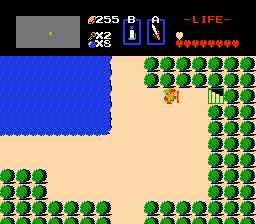I have never been much of a handheld gamer (until recently with my Vita and 3DS), so I have not decided whether or not I will go back and play the many I've missed out on Gameboy, GBA, etc... through the years, but it is a possibility.
I will be playing each game on the original console it was released on to get a more authentic experience. While all of them could be played on my Wii U via Virtual Console, or on my 3DS, there is just something about playing them with the original system with the original controller.
As I write this, I have completed 'The Legend of Zelda' on NES last week and have begun 'Zelda II: The Adventure of Link'
Here is my review of the first one:
On a scale of 1 to 5:
Graphics: 2
Music: 3
Puzzle Difficulty: 2
Combat Difficulty: 3
Items: 3
Story: 1
(The above scores do not represent how good or bad the game is. I will be using them to compare these areas to the other games in the series as I replay them.)
Graphics: It is an NES game, so it isn't surprising that the graphics aren't top notch compared to modern games. Most enemies just get a palate swap to differentiate how difficult they are. Red creatures are the weak form, while blue is the stronger form. The same goes for a few items and environments. There is a blue ring, red ring, blue candle, and red candle as well as green bushes, orange bushes, green mountains, and brown mountains. I really don't have any complaints about the graphics and am actually impressed by the size of the world and the many secrets contained within. For someone who isn't playing through nostalgic lenses, the few hiccups that occur in most NES games may be distracting, but they do not bother me. These include frame rate drop and weird blinking items or enemies.
Puzzle Difficulty: If you had never played a Zelda game before and began playing this one without looking at the manual or the internet for help, the puzzles may provide a challenge. However, having played other games in the series, I mostly knew what to look for when I was stuck. This room is a dead end? Let me try to bomb each wall or move these blocks! Unlike later entries in the series, there are no cracks in the walls to give you a hint as to where to bomb. The game also gets easier if you map out the world and dungeons as you go. I was never stumped on any puzzle in the game and I played through without using help from the internet or game guides.
Puzzles include: repeating areas that you must pass through in a certain sequence to advance, hidden stairs in bushes, walls, and rocks, bosses that need to be defeated with a certain item, and moving blocks to reveal doors.
Combat Difficulty: For the most part, this game's combat wasn't too tough although there were a few sections that gave me some trouble. Most notably dungeon 6 (those cursed pancake monsters kept eating my shield!) For those who have played a 2D Zelda before, the combat is basically the same, you can attack in four directions (up, down, left, right) and when your health is at maximum, your sword shoots a beam that can hit enemies across the screen. As you progress through the game you can find sword, shield, and armor upgrades as well as heart containers to increase your life. This really helps you survive the tougher enemies in the last few dungeons. Many of the items you pick up in the dungeons can be used as weapons, as well.
Items: Most of the iconic items in the series have their origins in this game. The boomerang, bow and arrow, bombs, and flute all make an appearance along with items such as a magic wand, meat on a bone, raft, ladder, and candle. Overall, each item felt useful, other than the one use items such as the meat (used to get past an enemy blocking the way). The boomerang was probably the most helpful as it could be used to stun enemies giving you time to close the distance to attack them. It was extremely helpful with enemies that jump around or move fast.
Story: NES Games weren't known for their stories and The Legend of Zelda is no different. You are given just a brief introduction as to what is happening (Gannon kidnapped Zelda to attempt to gain control of the complete Triforce). You are given the task to retrieve the Triforce pieces and rescue her. That's about all the story you will get.
You will encounter several NPC's throughout the game, but they do little more than give you a hint or sell you items. There are even some that will let you play a game of chance to increase your Rupee count.
It is also nice to see the origin of many items, creatures, and key elements of the series here.
If you are a fan of the Zelda series and have never played this one, I would highly recommend it. Twenty-nine years after it's release, it is still a blast to play and offers up a nice challenge.




-2.jpg)



No comments:
Post a Comment